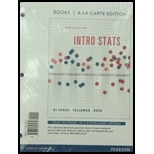
21–34. What’s the design? Read each brief report of statistical research, and identify
a) whether it was an observational study or an experiment.
If it was an observational study, identify (if possible)
b) whether it was retrospective or prospective.
c) the subjects studied and how they were selected.
d) the parameter of interest.
e) the nature and scope of the conclusion the study can reach.
If it was an experiment, identify (if possible)
b) the subjects studied.
c) the factor(s) in the experiment and the number of levels for each.
d) the number of treatments.
e) the response variable measured.
f) the design (completely randomized, blocked, or matched).
g) whether it was blind (or double-blind).
h) the nature and scope of the conclusion the experiment can reach.
32. A dog food company wants to compare a new lower-calorie food with their standard dog food to see if it’s effective in helping inactive dogs maintain a healthy weight. They have found several dog owners willing to participate in the trial. The dogs have been classified as small, medium, or large breeds, and the company will supply some owners of each size of dog with one of the two foods. The owners have agreed not to feed their dogs anything else for a period of 6 months, after which the dogs’ weights will be checked.
Want to see the full answer?
Check out a sample textbook solution
Chapter 11 Solutions
Intro Stats
- A company found that the daily sales revenue of its flagship product follows a normal distribution with a mean of $4500 and a standard deviation of $450. The company defines a "high-sales day" that is, any day with sales exceeding $4800. please provide a step by step on how to get the answers in excel Q: What percentage of days can the company expect to have "high-sales days" or sales greater than $4800? Q: What is the sales revenue threshold for the bottom 10% of days? (please note that 10% refers to the probability/area under bell curve towards the lower tail of bell curve) Provide answers in the yellow cellsarrow_forwardFind the critical value for a left-tailed test using the F distribution with a 0.025, degrees of freedom in the numerator=12, and degrees of freedom in the denominator = 50. A portion of the table of critical values of the F-distribution is provided. Click the icon to view the partial table of critical values of the F-distribution. What is the critical value? (Round to two decimal places as needed.)arrow_forwardA retail store manager claims that the average daily sales of the store are $1,500. You aim to test whether the actual average daily sales differ significantly from this claimed value. You can provide your answer by inserting a text box and the answer must include: Null hypothesis, Alternative hypothesis, Show answer (output table/summary table), and Conclusion based on the P value. Showing the calculation is a must. If calculation is missing,so please provide a step by step on the answers Numerical answers in the yellow cellsarrow_forward
 Glencoe Algebra 1, Student Edition, 9780079039897...AlgebraISBN:9780079039897Author:CarterPublisher:McGraw Hill
Glencoe Algebra 1, Student Edition, 9780079039897...AlgebraISBN:9780079039897Author:CarterPublisher:McGraw Hill College Algebra (MindTap Course List)AlgebraISBN:9781305652231Author:R. David Gustafson, Jeff HughesPublisher:Cengage Learning
College Algebra (MindTap Course List)AlgebraISBN:9781305652231Author:R. David Gustafson, Jeff HughesPublisher:Cengage Learning Holt Mcdougal Larson Pre-algebra: Student Edition...AlgebraISBN:9780547587776Author:HOLT MCDOUGALPublisher:HOLT MCDOUGAL
Holt Mcdougal Larson Pre-algebra: Student Edition...AlgebraISBN:9780547587776Author:HOLT MCDOUGALPublisher:HOLT MCDOUGAL



